AW7915-BMD IS A WIFI6 11AX 2T2R 1800MBPS M.2 MODULE BM KEY BY MT7915DAN
Certificating soon:
CE, FCC ID: TKZAW7915-BMD; IC ID: 9968A-AW7915BMD; NCC:
AW7915-BMD is a WiFi6 M.2 Module BM Key 2T2R (in circuit 4 RF outputs 2×2.4GHz, 2x5GHz, 2 radios in driver) 2 x dual bands RF connectors based on Mediatek MT7915DAN which is a WiFi single chip which supports 1800 Mbps (573+1201) PHY rate with PCIe2.1. It fully complies with IEEE 802.11ax/ac and IEEE 802.11 ac/a/b/g/n standards, offering feature-rich wireless connectivity at high standards, and delivering reliable, cost-effective throughput from an extended distance.
AW7915-BMD is with 4T4R RF outputs in circuit too. Due to 2.4GHz and 5GHz can be combined in one RF output. So 1×2.4GHz and 1x5GHz are combined to 1x(dual bands). Total are 2x(dual bands) outputs.
In Linux “ifconfig” command, you can see two radios, ra0 and rai0, means you can have two radios in the meantime and dual bands dual concurrents.
Optimized RF architecture and base band algorithms provide superb performance and low power consumption. Intelligent MAC design deploys a high efficient offload engine and hardware data processing accelerators which completely offloads Wi-Fi task of the host processor. MT7915DAN is designed to support standard based features in the areas of security, quality of service and international regulations, giving end users the greatest performance any time and in any circumstance.
MT7915DAN is designed to support high data throughput over WiFi. The host interface PCIe are integrated to provide stable bandwidth between the host platform and MT7915DAN.
DEEP SLEEP MODE:
Multiple power domains are implement on chip. In deep sleep mode, the PMU could be configured in a low power state to save the power consumption.
Two CPU systems: There are both 32-bits RISC MCU subsystem. The CPU has its local memory. There are several options of clock frequency to provide the optimal performance with the best power consumption. The 32-bit RISC MCU is used to do clocck control, power management, and host interface configuration. PDMA (packet DMA) engines are integrated to support on-the-fly data buffer management.
MT7915AN had the WiFi MAC and BBP subsystem and use with MT7975DN together, which provide the best-in-class radio and low power performance. And the Wi-Fi MAC and BBP subsystem and use with MT7975DN together, which provide the best-in-class radio and low power performance.
With the advent of 802.11ax/ac, multi-user MIMO (MU-MIMO) is defined. MT7915DAN supports MU-MIMO with different configurations.
MT7915DAN BLOCK DIAGRAM
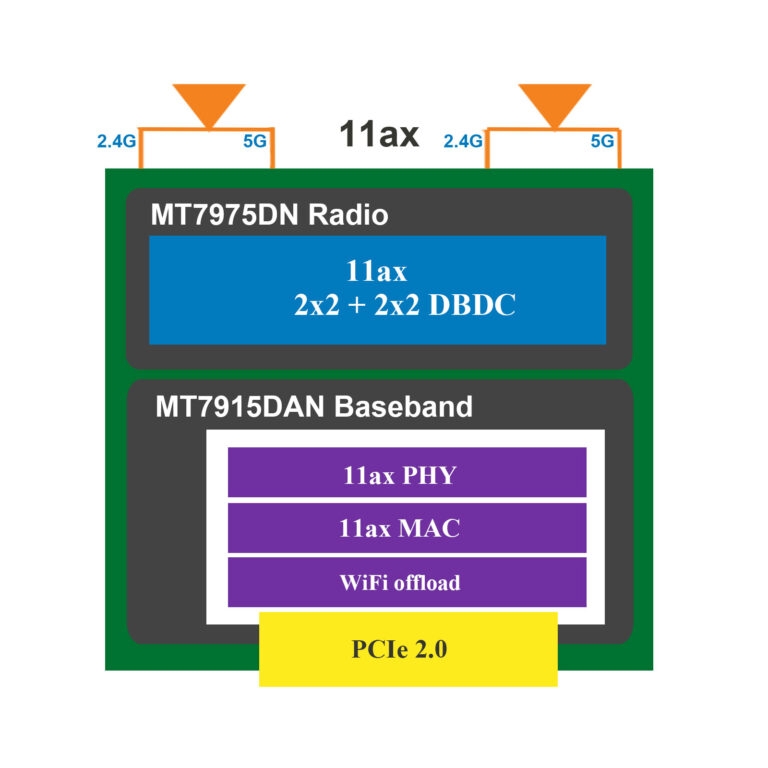
FEATURES:
- 2T2R in 2.4G+2T2R in 5G with support of up to 573+1201Mbps PHY rate
- Supports 20, 40, 80 channels
- HE MCS0-11 BW20/40/80MHz with Nss=1~2
- Short Guard Interval
- Space-time block code (STBC)
- Low Density Partiy check (LDPC)
- Support digital pre-distortion to enhance PA performance
- Smoothing (channel estimation) extension to MIMO case
- DFS radar detection
- Embedded ARM Cortex R4 processor for full host CPU offload
- Embedded 32-bit RISC microprocessor
- Support STBC, LDPC, TX Beamformer and RX Beamformee
Decoded BW20/40/80 up to 4×2 MU materix feedback - Greenfield, mixed mode, legacy modes support
- Highly integrated RF with 40nm low power process
- Noise mitigation:
- Supports background scan function for fast channel switching
- Supports spectrum analysis for non-Wi-Fi signals
- Intelligent power saving
- WFA WMM, WMM PS (QoS)
- Integrate high efficiency internal 4G/5G PAs
- Intelligent Calibration (iCal) reduces the production time
- Integrate high efficiency internal 4G/5G PAs
SPECIFICATION:
| Standards | Wireless: IEEE 802.11ax/ac/b/g/n (2Tx2R) |
| Data Rate | IEEE802.11ax 1201Mbps @TX/RX IEEE802.11ac 1733Mbps @TX/RX IEEE802.11a/n 600Mbps @TX/RX IEEE802.11a/g 108Mbps IEEE802.11b 22Mbps |
| Output Power | 11b: 23dbm+/- 1.5dbm @11Mbps 11g: 20dbm+/- 1.5dbm @54Mbps 11g/n: 20dBm +/- 1.5dbm @MCS7, HT20 17dBm@MCS7,HT40 11a: 19.5dBm +/- 1.5dbm @54Mbps 11a/n: 19.5dBm+/- 1.5dbm @MCS7, HT20 17dBm@MCS7, HT40 11ac HT20: 20+/-1.5dBm @MCS8 11ac HT40: 17+/-1.5dBm @MCS9 11ac HT80: 14.5+/-1.5dBm @MCS9 11ax HT20: 20+/-1.5dBm @MCS9 11ax HT40: 17 +/- 1.5dBm @MCS9 11ax HT80: 14.5 +/- 1.5dBm @MCS11 |
| Receiver Sensitivity | 11b: -99dBm @11Mbps 11g: -95dBm @54Mbps 11g/n: -90dBm @HT20, MCS7 -86dBm @HT40, MCS7 11a: -90Bm @54Mbps 11a/n: -85dBm @HT20, MCS7 -81dBm @HT40, MCS7 11ac: -90dBm +/- 2dBm @VHT20 MCS8 11ac: -85dBm +/- 2dBm @VHT40 MCS9 11ac: -68dBm +/- 2dBm @VHT80 MCS9 11ax: -61dBm +/- 2dBm @HE20 MCS11 11ax: -58dBm +/- 2dBm @HE40 MCS11 11ax: -55dBm +/- 2dBm @HE80 MCS11 |
| Antenna | External Antenna connector (IPEX) x2 |
| Frequency Range | US, Canada 2.412GHz~2.462 GHz (CH1~CH11) EU, Japan: 2.412GHz~2.472GHz (CH1~CH13) 5.15GHz ~5.875GHz |
| Software | Security: 64/128-bit WEP Encryption, WPA, WPA2 Driver: Linux |
| Operating Voltage | DC 3.3V ± 5% |
| Temperature | Operating: 0°C ~ +70°C Storage : -20°C ~ +90°C |
| Humidity | Operating Humidity: 10%~90% non-condensing Storage Humidity: 10%~90% non-condensing |
| Dimension | 52(H) x 30(W)mm |
Power consumption maximum is 9W, average is 4 – 8W.
Main board Power Supply design please provide 3.3V 3A, minimum 3.3V 2.5A.
I thought I’d follow up with you, to let you know what I discovered:
It’s a PCI-e device, so USB doesn’t come into it. It does work with the thunderbolt adapter designed for SSDs! An M.2 SSD will sometimes use up to 3A, so I think the power will be okay.
See photo in product pictures 🙂









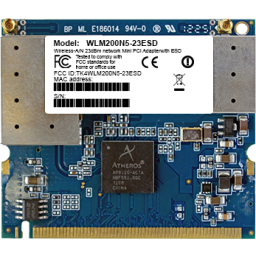
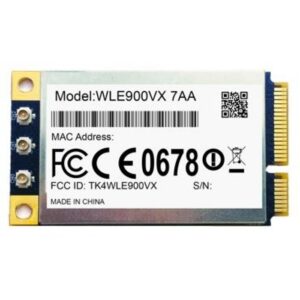

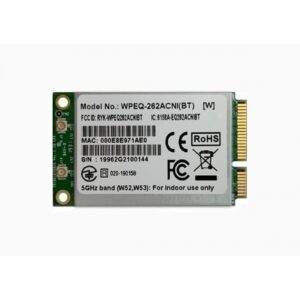
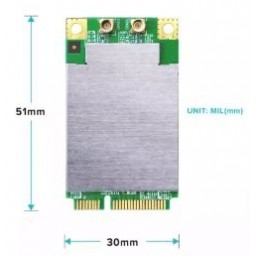
Reviews
There are no reviews yet.